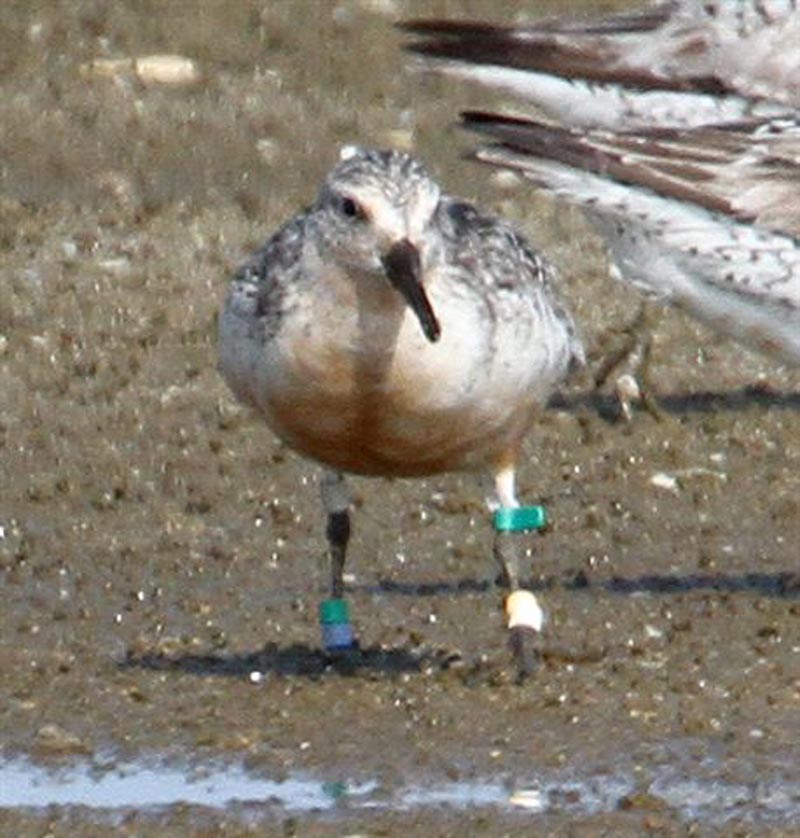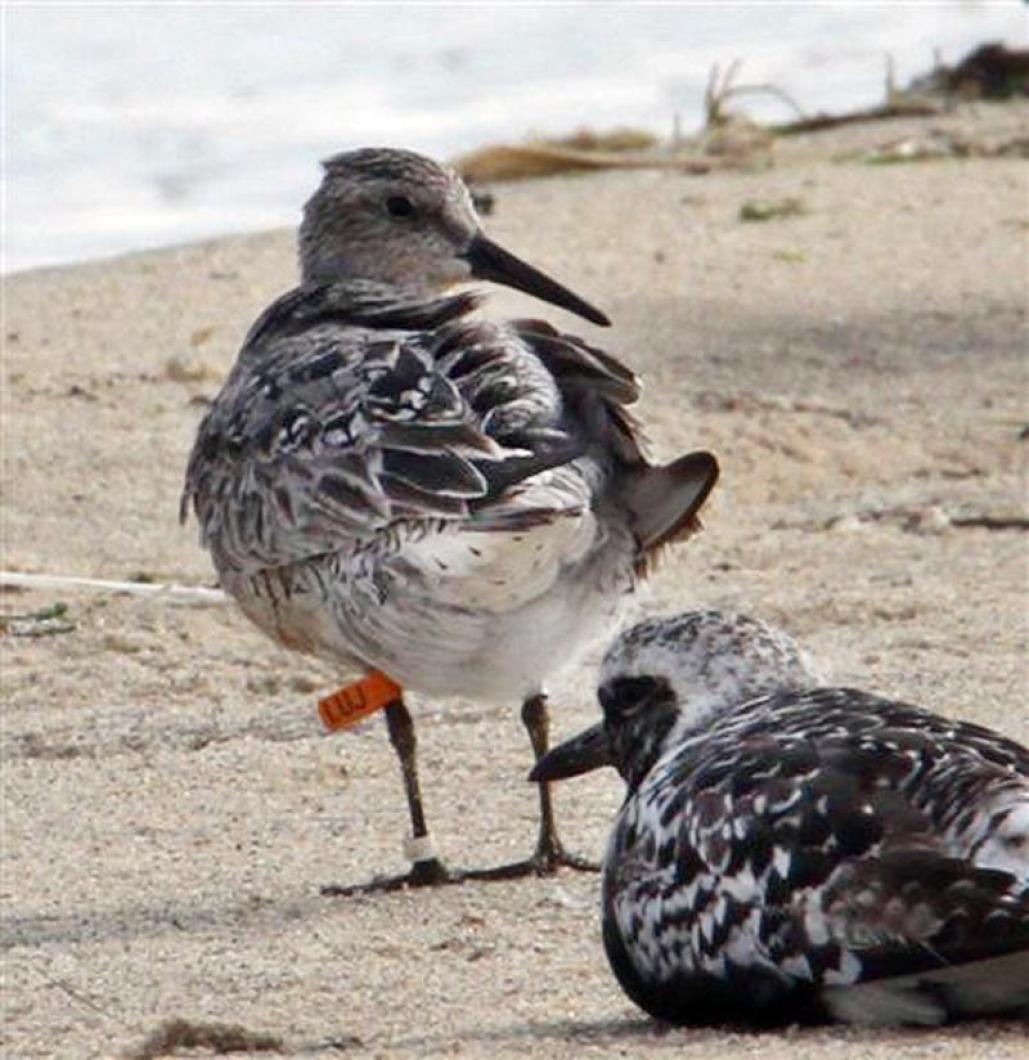Red knots are a not something you tie, but a type of shorebird that is causing quite a stir in the birding world. A bit of history: the red knot’s Latin name is Calidris canutus, a moniker which was given this sandpiper by Linnaeus to honor the Danish king, Canute or Knut. King Knut was well-known for trying to hold back the tides. This makes perfect sense; if I were a sandpiper depending on horseshoe crab eggs or clams, I would want the tide to stay low so I could feed.
The beach robin, which is another name for the red knot, has seen a shocking decline in numbers in the last 20 years. Some say the numbers of red knots have fallen by 90 per cent in that period. It is hard to say what the cause of this demise is, although there are some theories. One is that the food they require to refuel between their wintering ground in Argentina and their breeding grounds in the Arctic is depleted. Horseshoe crab eggs are their mainstay on the northward trip, and these crabs have been used as bait and scientific work, so the population is way down.
The red knot, which is the largest of our beach-going sandpipers, has an interesting lifestyle. It nests in the Arctic tundra, either on islands or peninsulas and feeds primarily on insects, although they also nibble on various plants as well. Once they have reared their young, the beach robins head south on a long trek ending up in Argentina in the Patagonia/Tierra del Fuego area. A few stop short of that and winter in Georgia and Florida’s west coast. It is usually in late August or early September when we see a few red knots on the Vineyard. The food they use for fuel on the way south is usually Gemma or Amethyst clams, small crustaceans and worms.
Last week Lanny McDowell, John Banks and I spotted more red knots than we had ever seen on the Vineyard. We counted 48 individuals at Quansoo on Tisbury Great Pond. I alerted both Brian Harrington and Brad Winn, both red knot experts at Manomet Center for Conservation Sciences to report our find. Brian Harrington was very interested and reported that the Gemma clams which are usually on the flats at Pleasant Bay in Chatham are not there this year. This is the species the red knots usually use as fuel for their southern migration. Brian suggested that a number of knots have probably come to the Vineyard to find an alternative food source. The red knots at Quansoo were pigging out on seed steamer or soft-shelled clams.

We found three color-banded red knots at Quansoo on August 17 and Lanny McDowell found a fourth banded bird at Norton Point on August 19. I have been doing some research on these banded birds and found that one red knot, that had a lime green band #30A, was banded on May 23, 2010 at Reeds Beach, New Jersey. It was re-sighted at Kimbles Beach in New Jersey on May 25, 2010 and then again on October 5, 2011 on Wolf Island National Wildlife Refuge in Georgia, and again on May 19, 2012 at Mispillion Harbor, Delaware and then finally on South Beach at Quansoo in Chilmark on August 17, 2012. Cool!
Two other red knots were banded with multiple color bands and Brad Winn suggested that one red knot which had a dark green flag and multiple color bands on each leg was most likely banded in Delaware or New Jersey before 2005, more likely in the late 1990’s-2002. Brian Harrington added that in 2002 the banders started using single flags with a letter/number combination such as 30A that we found at Quansoo and quit using multiple color bands. Now it is easier to determine where the bird was banded. If they wear a white flag the bird was banded in Canada, a green flag in the USA, a blue flag in Brazil, an orange flag in Argentina and a red flag in Chile. Therefore the red knot that Lanny McDowell found at Norton Point was banded in Argentina as it had an orange flag with the letters LUG on it. Brad guesses that the bird was probably banded in Patagonia or Terra del Fuego. Brad sent this information to Argentina and as of yet we have not heard back. Stay tuned!
Lanny McDowell suggested that those interested in learning more about red knots check out the website globalconservationalliance.org
Bird Sightings
Bob Shriber birded Norton Point and the Farm Institute late in afternoon on August 18. The highlight at the Farm Institute was five golden plovers on the only semi-plowed field. Bob counted eighteen black skimmers at Norton Point. I figure there were four pair (4x2=8), they each could have had 4 chicks, (4x4=16); for a total of 24 black skimmers in all, all very impressive for the first successful nesting of black skimmers on-Island!
Luanne Johnson and Bert Fischer went to see the black skimmers at Norton Point on August 19. They paddled over and found all of the skimmers loafing along the edge of the bay except for two chicks huddled in the dune grass near the pond shore. Jeff Bernier was out photographing and got some nice shots of the youngsters and Bert got a nice shot of Jeff photographing. Lanny McDowell was at Norton Point later in the day and counted 19 black skimmers, 11 of which were young.
Ann Floyd from Chappaquiddick saw a black skimmer working Cape Pogue Bay. This was a first for her, and as Luanne Johnson noted “very cool, they are working all of the possible sites for skimming.”
Bob Shriber found two Forster’s terns at Red Beach in Aquinnah and had eight great egrets off Clam Cove in Chilmark and saw two others at Lobsterville for a total of ten.
Rob Culbert spotted a solitary sandpiper at the little pond at the Manuel Correllus State Forest on August 18 and Lanny McDowell photographed it.
Ken Magnuson had a raptor week photographing a mature red-tailed hawk being harassed by an Eastern kingbird and then a fabulous shot of a Cooper’s hawk overhead on August 21. Both were taken at the Vineyard Golf Club.
Matt Pelikan had four red-breasted nuthatches calling around the Wakeman Center on August 22 and figures they are a family group that nested here. They might be early migrants, but both Matt and I doubt it.
Tom and Barbara Rivers have a family of five ruby-throated hummingbirds around their Chilmark home. One of the three immatures is a male and is already getting a “ruby” throat.
Larry Hepler and Sarah Mayhew both spotted whimbrels on August 20; Sarah at Quansoo and Larry at Black Point.
Ray Andrewsen reports seeing a pine warbler at West Chop and sent me a very fuzzy I-phone photo of what he thought might be a short-eared owl. Unfortunately, I was unable to determine the identity of the owl and suggested he try with a camera. I hope he finds the bird again. It has been quite a while since a short-eared owl was reported on the Island.
Please report your bird sightings to the Martha’s Vineyard Bird Hotline at 508-645-2913 or e-mail to birds@mvgazette.com. Susan B. Whiting is the coauthor of Vineyard Birds and Vineyard Birds II. Her website is vineyardbirds2.com.







Comments
Comment policy »